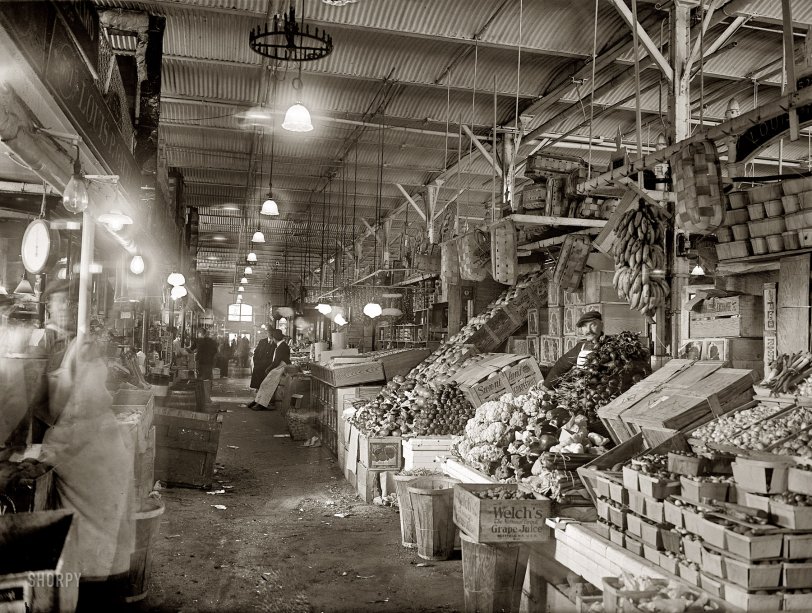


Framed or unframed, desk size to sofa size, printed by us in Arizona and Alabama since 2007. Explore now.
Shorpy is funded by you. Patreon contributors get an ad-free experience.
Learn more.

- Freeze Frame
- Texas Flyer wanted
- Just a Year Too Soon
- WWII -- Replacing men with women at the railroad crossing.
- Yes, Icing
- You kids drive me nuts!
- NOT An Easy Job
- I wonder
- Just add window boxes
- Icing Platform?
- Indiana Harbor Belt abides
- Freezing haze
- Corrections (for those who care)
- C&NW at Nelson
- Fallen Flags
- A dangerous job made worse
- Water Stop
- Passenger trains have right of way over freights?
- Coal
- Never ceases to amaze me.
- Still chuggin' (in model form)
- Great shot
- Westerly Breeze
- For the men, a trapeze
- Tickled
- Sense of loneliness ...
- 2 cents
- Charm City
- What an Outrage
- Brighton Park
Print Emporium
Center Market: 1922

"Center Market, 1922." Produce vendors in Washington, D.C. National Photo Company Collection glass negative. View full size.
A very familiar sight to me
This market looks very much like the market where I shopped for fruits and vegetables in the 1980s in Santa Cruz, Bolivia.
Look at all those wooden crates. Those would be cardboard boxes today.
Typhoid-Free Watercress
Sometimes a chance phrase reminds me that there were some things in the past that I never could have imagined. I'm completely derailed by the statement in Mr. Gotti's obituary that he attracted an "elite clientele of the rich and powerful" in part by securing a steady supply of typhoid-free watercress. Thanks to him, Washington hostesses could confidently serve their guests watercress sandwiches without having to budget for funeral flowers later. Who knew that luncheon buffets could be that exciting?
Still the Same
Many who don't travel fail to realize that markets around the world are still like this with, generally, minor changes such as better lighting and...and...well, better lighting.
Is this the same Gatti who later went into the butchery business?
Louis Gatti
The stand on the left, as seen by the sign overhead, was run by Louis P. Gatti. Gatti emigrated to the U.S. in 1886 and operated this fruit and vegetable stand at Center Market on Pennsylvania Avenue (present site of the National Archives) from about 1900 to 1925. In the 1910s, the family lived at 736 5th Street, N.W., a site now across from the Government Accountability Office where a Red Roof Inn is located.
Louis Gatti was one of the most successful of many members of his extended family that went into the fresh produce business in Washington. At his death in 1969, the Washington Post noted that his fruit and vegetable stand "won the culinary cachet of early 20th century Washington.[T]he fine quality of his fruits and vegetables — such as strawberries from Plant City, Fla., and typhoid - free watercress grown in pure mineral springs — won him an elite clientele of the rich and powerful in a day when even the most haughty of the city's housewives did their own daily grocery shopping." His wife’s obituary, from 1948, further elaborates: "Numbered among their clients were Presidents Taft, Wilson, and Harding, Cabinet officials, diplomats, and official leaders of the day. Mrs. Gatti often reminisced about the time Mrs. William Howard Taft came to her after the President's inauguration, asking if she would take as good care of the White House larder as she had the Taft residence." Gatti would take charge of procuring the best produce; his wife Mary Angela was in charge of operating the stand. Gatti became one of the first produce merchants to place orders directly with farmers outside the city, simplifying the buying process.
In 1921, he retired from the produce business, turning his firm over to his sister-in-law and her husband, and concentrated on investing in real estate. By this time, he had grown quite wealthy, and his wealth drew some undesirable attention. In October of that year, Mrs. Gatti received a "blood-smeared" letter at the family home on 5th Street. The letter, signed by the "Black Hand" (the Mafia), demanded that she pay $15,000 "or your home goes in the air." She was instructed to wait for another letter with instructions on how to pay, and that letter finally came in January 1922. The terrified Mrs. Gatti placed 15 $1,000 bills into a bag for two neighborhood boys to take to a mysterious stranger, who was supposed to pick it up a couple of blocks away from the house. However, a visitor to the Gatti household, alarmed at the proceedings, called the police, who intercepted the two boys and apparently scared off the threat-maker. The police were unable to track down the extortionist, who they believed was not actually connected to the Mafia but perhaps instead associated with a local wholesale establishment because of the way the threat letter was stenciled. According to the newspaper account, Mrs. Gatti "intimated that she and her family would flee the city," and that is more or less exactly what they did, moving out to Park Road N.W. in the "suburb" of Columbia Heights within the next year or two. It is unclear if anything further came of the whole unpleasant affair. After Mrs. Gatti died in 1948, Louis Gatti moved in with his son Michael on Foxhall Road N.W., where he resided until his death in 1969 at the age of 96.
























On Shorpy:
Today’s Top 5